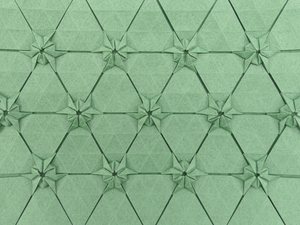Scissors Tessellation

This is my tessellation of Shuzo Fujimoto’s CFW 87 Scissors. Each molecule can be rotated independently of others. As far I’m aware, Fujimoto himself never tessellated this pattern. Many other of his stars are likewise based on tessellation molecules which I was not able to find in tessellated form in any of his publications. Perhaps he didn’t realize they could be tessellated, or perhaps he knew but just didn’t publish it.
Such a situation poses an interesting challenge when I try to organize models presented on my web page by linking designs to their “base models”. From a morphological point of view, I consider a tessellation of a molecule to be the “primary” variant, with the star being a special case consisting of just a single molecule. However, from a historic point of view, in this case the stars came first and the tessellation later, with the original author probably not being aware of its existence. So, if I were to follow the historic point of view rather than the morphological, the relation would be reversed.
Comments